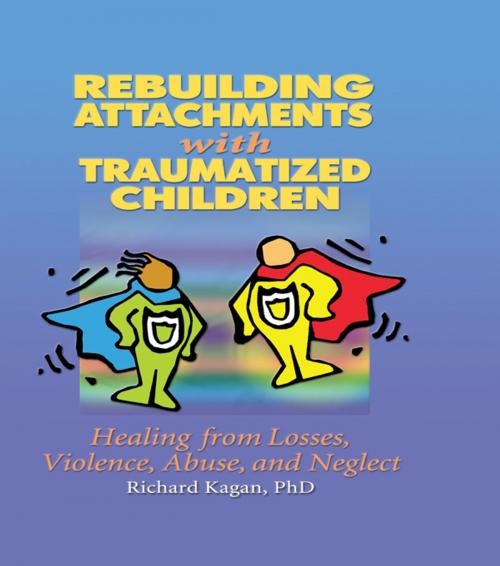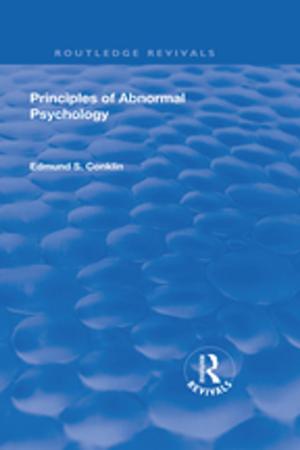Rebuilding Attachments with Traumatized Children
Healing from Losses, Violence, Abuse, and Neglect
Nonfiction, Family & Relationships, Family Relationships, Abuse, Health & Well Being, Psychology, Mental Health| Author: | Richard Kagan | ISBN: | 9781136399794 |
| Publisher: | Taylor and Francis | Publication: | September 25, 2014 |
| Imprint: | Routledge | Language: | English |
| Author: | Richard Kagan |
| ISBN: | 9781136399794 |
| Publisher: | Taylor and Francis |
| Publication: | September 25, 2014 |
| Imprint: | Routledge |
| Language: | English |
Learn to build the trust you need to help children in crisis!
Rebuilding Attachments with Traumatized Children: Healing from Losses, Violence, Abuse, and Neglect is a therapeutic guide to helping troubled children move beyond the traumatic experiences that haunt them. Author Dr. Richard Kagan, Director of Psychological Services for Parsons Child and Family Center in Albany, New York, presents comprehensive information on how to understand-and surmount-the impact of loss, neglect, separation, and violence on children’s development, how to discover and foster strengths in children and their families, and how to rebuild connections and hope for children who are at risk of harm to themselves and others. This unique book is designed to be used in tandem with Real Life Heroes: A Life Storybook for Children (Haworth), an innovative workbook that helps children develop the self-esteem they need to overcome the worries and fears of their past through a creative arts approach that fosters positive values and a sense of pride.
Rebuilding Attachments with Traumatized Children helps children move from negative or suppressed memories to a more positive perspective, not by denying hardships, but by drawing strength from the supportive people in their lives. Practitioners can use the book as a framework and detailed guide to assessment, engagement, development of service plans, and implementation of attachment and trauma therapy. The book is a comprehensive model for working to build the trust necessary before other trauma therapy approaches can be successfully initiated.
Topics examined in Rebuilding Attachments with Traumatized Children include:
- attachment theory and research
- types of attachment problems
- PTSD behaviors
- permanency work with children in placement
- ADHD, bipolar, and RAD
- cognitive behavioral therapies
- storytelling therapies
- the myth of perfection
- neuropsychological patterns
- and much more!
Rebuilding Attachments with Traumatized Children is a rich resource for practitioners, academics, parents, adoptive parents, foster parents, grandparents, and anyone working to show troubled children how to learn from the past, resolve problems in the present, and build a better future.
Learn to build the trust you need to help children in crisis!
Rebuilding Attachments with Traumatized Children: Healing from Losses, Violence, Abuse, and Neglect is a therapeutic guide to helping troubled children move beyond the traumatic experiences that haunt them. Author Dr. Richard Kagan, Director of Psychological Services for Parsons Child and Family Center in Albany, New York, presents comprehensive information on how to understand-and surmount-the impact of loss, neglect, separation, and violence on children’s development, how to discover and foster strengths in children and their families, and how to rebuild connections and hope for children who are at risk of harm to themselves and others. This unique book is designed to be used in tandem with Real Life Heroes: A Life Storybook for Children (Haworth), an innovative workbook that helps children develop the self-esteem they need to overcome the worries and fears of their past through a creative arts approach that fosters positive values and a sense of pride.
Rebuilding Attachments with Traumatized Children helps children move from negative or suppressed memories to a more positive perspective, not by denying hardships, but by drawing strength from the supportive people in their lives. Practitioners can use the book as a framework and detailed guide to assessment, engagement, development of service plans, and implementation of attachment and trauma therapy. The book is a comprehensive model for working to build the trust necessary before other trauma therapy approaches can be successfully initiated.
Topics examined in Rebuilding Attachments with Traumatized Children include:
- attachment theory and research
- types of attachment problems
- PTSD behaviors
- permanency work with children in placement
- ADHD, bipolar, and RAD
- cognitive behavioral therapies
- storytelling therapies
- the myth of perfection
- neuropsychological patterns
- and much more!
Rebuilding Attachments with Traumatized Children is a rich resource for practitioners, academics, parents, adoptive parents, foster parents, grandparents, and anyone working to show troubled children how to learn from the past, resolve problems in the present, and build a better future.















